|
|
GeoAstro Applets |
Astronomy |
Chaos Game |
Java |
Miscel- laneous |
Kepler's Dream: Lunar Astronomy
Applet: The Earth and
the Sun seen from the Moon
 http://www.um.zagan.pl/kepler/kwz.htm |
Johannes Kepler's (1571-1630)
work "Somnium, sive Astronomia Lunaris" (A Dream, or
Lunar Astronomy) is a fantastic tale of a journey to
the Moon, which is called Levania by its inhabitants.
The short work was published posthumously in 1634 by
Kepler's son Ludovico. Embedded in the narrative frames Kepler describes in details how astronomical observations might appear if they were conducted on the Moon. The Moon is in synchronous rotation, keeping nearly the same face turned toward Earth at all times. One hemisphere of Levania (Moon) is always facing the Earth and one facing away, separated by the Divisor. Its inhabitants call the former hemisphere Subvolva (Under-Earth), and the latter Privolva (deprived-of-Earth). Our marvellous blue planet will never be seen from Privolva (Volva=Earth). Daemon ex Levania |
 |
Left: Topocentric view of the Moon, geographic coordinates from the text fields "Lat.", "Long.". |
 |
Right: The Earth (blue) and the Sun (red) as seen from a specified location on the Moon. The apparent diameter of the Earth (2°) is approximately four times the Sun's diameter (32'). The apparent diameters are magnified by a factor of 3.3, zoom may be disabled by a "Details" menu item. |
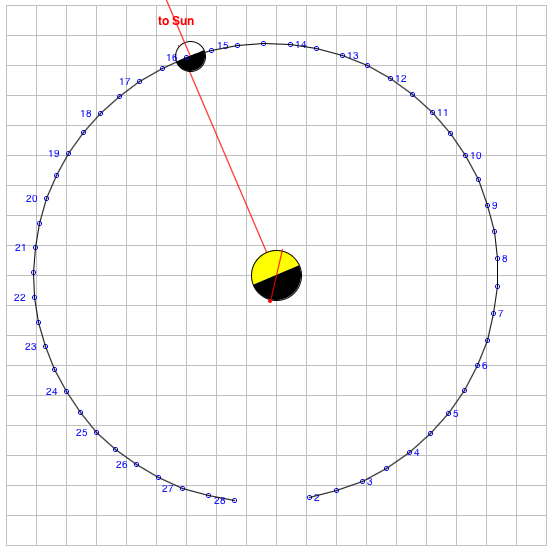 |
Select "Moon Orbit" from the View menu |
| You may use
the keys d, m, h, or n to increase the
date, month, hour, or minute, or Shift key and d, m, h, or n to decrease the date, month, hour, or minute ! Click the applet first ! |
|
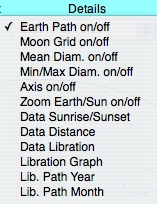 |
Details and view options. |
 |
Selenographic coordinates of the
observer on the Moon, northern latitude positive, eastern negative, eastern longitude positive, western negative. |
  |
Geographic
coordinates of the location on the Earth, enter decimal values: northern latitude positive, eastern negative, and press return key, eastern longitude positive, western negative, and press return key. |
 |
The (optical) in latitude and longitude. |
| Some observations in Levania: | |
 |
The blue curve
is the path of the Earth for the month selected,
looking like an ellipse, but not closed. The red line is the axis of the Earth. 0°N, 0°E is marked by a white dot. Kepler is neglecting libration of the Moon: "The moon always turns the same spots toward the earth.Therefore the line connecting the centers of the earth and the moon always pierces the moon's surface in the same spot...". (Rosen)  |
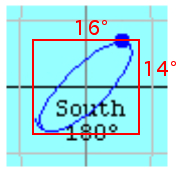 |
The maximum
libration in latitude is given by the sum of the
inclination of the Moon's rotation axis to the
ecliptic (1° 32), and the inclination of the Moon's
orbit to the ecliptic (5° 09'): 1° 32 + 5° 09' =
6° 41. The maximum libration in longitude may be up to
8°. Therefore the ellipse lies within an recangle of about 16° x 14°. |
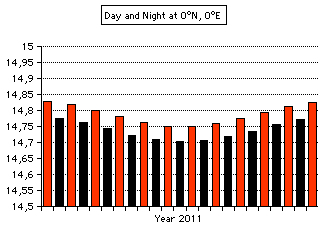 |
At sub-earth
locations (subvolva) days (red bars) are always longer
than the duration of nights (black bars). The mean difference is about 1.2 hours. |
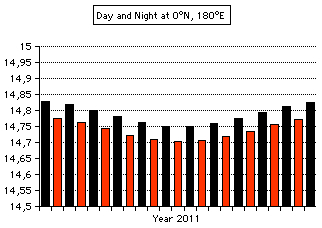 |
At
trans-earth locations (privolva) nights (black bars)
are always longer than days (red bars). The mean difference is about 1.2 hours. |
 |
Full Moon, seen from the Earth, New Earth, seen from the Moon. |
 |
Full Moon, seen from the Earth, New Earth, seen from the Moon. |
 |
New Earth, seen from the Moon. |
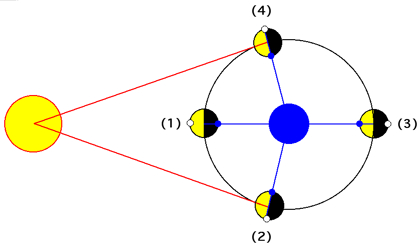 |
For a
Sub-Earth location (subvolva, small blue circle): (2) sunrise (3) noon (4) sunset (1) midnight The day-arc (2-3-4) is longer than the night-arc (4-1-2). For a Trans-Earth location (privolva, small white circle): (2) sunset (3) midnight (4) sunrise (1) noon The night-arc (2-3-4) is longer the day-arc (4-1-2). |
 |
An
eclipse of the Sun begins: e.g. 2010, Dec 10, about 12 UT On the Earth there is an eclipse of the Moon. |
  |
Location on
the Moon: 30° N, 30° E Sunrise on 2011, Oct 31, at 21:06 UT The divisor between day and night is crossing the location. |
| Select "Data
Sunrise/Sunset" from the "Details", please be patient waiting for the calculation. 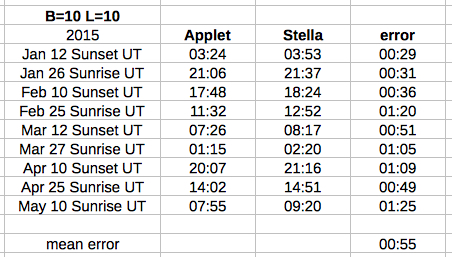 |
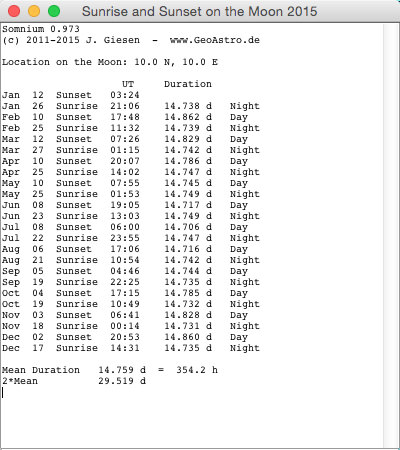 The duration of a lunar day (14.764 days) is half a synodic month (29.5306 days). |
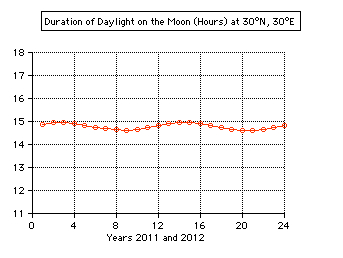 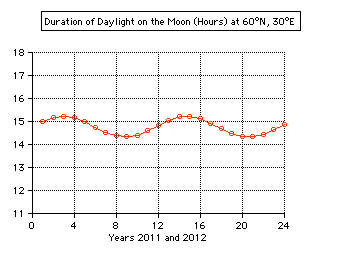 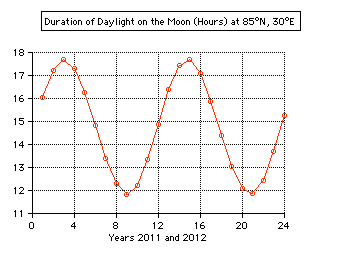 |
Within mean
latitudes of the Moon there is always nearly equinox:
the difference of daylight (sunlight) is small,
increasing towards the pole. Daylight duration: 30° N: 14.78 d +/- 0.17 d Daylight duration: 60° N: 14.78 d +/- 0.45 d Daylight : 85° N: 14.78 d +/- 2.9 d |
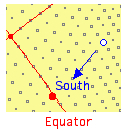  |
Lunar noon at 30 N, 30 E: 2011, Nov 8 at 5:32 The subsolar point (red) is exactly south of the location(white). |
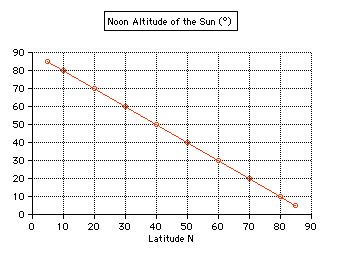 |
The altitude
of the Sun (and the Earth) at lunar noon is depending
on the selenographic latitude of the observer. Kepler is writing: "The inhabitants of this spot [i.e. the sub-earth point] have our earth, that is, their Volva, overhead. But in any place which is distant from this spot by a given number of degrees of a grat circle, Volva seems to deviate from the zenith by an equal number of degrees in the heavens." |
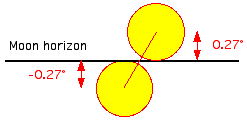 |
On the Moon,
sunrise or sunset takes about 70 minutes (between
upper/lower limb). On the Earth, at 50° latitude, sunrise or sunset takes only 4 minutes. |
|
Accuracy of the
applet
The altitude and azimuth of the Earth as seen from different positions on the Moon (latitude B, longitude L) were compared with Stellarium, using 7 dates (Jul/Aug 2015, at 20 UT). The mean error of the azimuth angle increases for high altitudes:  Starry
Night CSAP 7 was used to check the
altitude, azimuth,
elongation, and illumination of the Earth as seen
from the Moon:
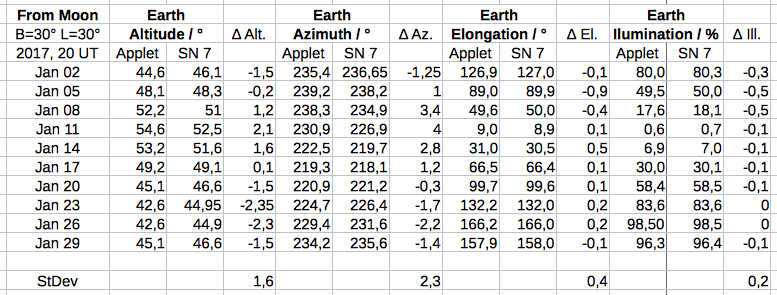  Position of the Earth (2017, Jan 2, 20 UT) and path of the Earth as seen from the Moon (B=30°E, L=30°E), 2017 Jan The altitude and azimuth of the Sun
as seen from different positions on the Moon
(latitude B, longitude L) were compared with
Stellarium,
using 7 dates (Jul/Aug 2015, at 20 UT). The mean
error of the azimuth angle increases for high
altitudes:
 Comparing Starry Night CSAP 7, Stellarium
0.15.1 and my Somnium Applet:
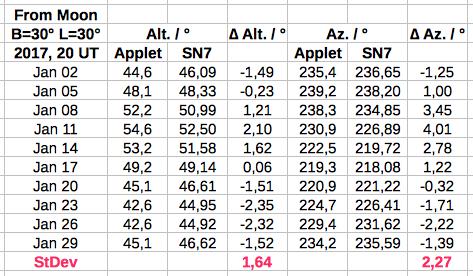 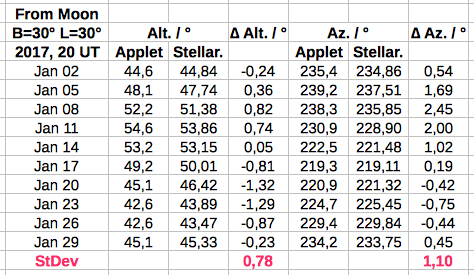 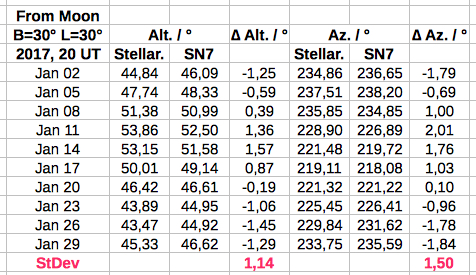 The results of
my applet are closer to Stellarium than to SN 7.
|
|
More applet
Moon Motion
(geocentric) More details:
Moon Data
Cosmic
voyages: authors and texts
Applet:
Solar System Simulator (Keith
McClary)
watch the selenocentric
motion of the Sun, the Earth, Venus, and Mars...
|
|
|
Johannes
Kepler: Somnium, seu Opus posthumum de
astronomia lunari Die
Bewegung des Mondes, Anhang: Fragen zur
Mondbewegung (PDF, U. Backhaus) Der
Mond, das unbekannte Objekt (U. Backhaus) Lukian
von Samosata: Die Wahre Geschichte
(Projekt Gutenberg) G. A.
Bürger: Freiherr von Münchhausen: R. E.
Raspe: The Surprising Adventures of Baron
Munchausen |
| Books |
| Günther, Ludwig: Keplers Traum
vom Mond, B.G. Teubner, Leipzig 1898. Johannes Kepler: Der Traum, oder: Mond-Astronomie. Somnium sive astronomia lunaris, aus dem Lateinischen von Hans Baumgarten, herausgegeben und mit einem Leitfaden für Mondreisende von Beatrix Langner. Matthes & Seitz, Berlin 2011. Edward Rosen: Kepler's Somnium: The Dream, or Posthumous Work on Lunar Astronomy, Translated with a Commentary, Dover Publications 2003. Jaritz, Kurt: Utopischer Mond. Mondreisen aus drei Jahrtausenden. Stiasny, Graz 1965. Brunner, W.: Von Stern zu Stern. Eine Weltschau von verschiedenen Himmelskörpern aus, Rascher & Cie., Zürich 1923. Kepler's Somnium: The Dream, or Posthumous Work on Lunar Astronomy. Dover Publications 2003 Jean Meeus: Mathematical Astronomy Morsels, Willmann-Bell, p. 29-36. |
© 2011-2023 J. Giesen
Last
update:
2023,
Oct 06
![]()